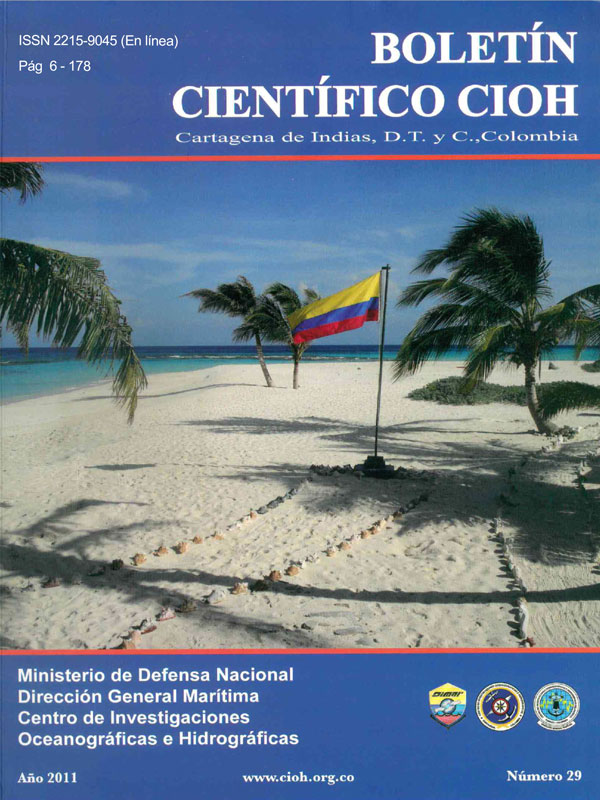Cambios en la línea de costa del Cayo Serranilla entre 1944 y 2009, Archipiélago de San Andrés, Colombia
DOI:
https://doi.org/10.26640/22159045.231Keywords:
Coastline variation, DSAS, Serranilla Cay, emerged areaAbstract
The Serranilla Key coastline variation was determined by the comparison of coastlines extracted from images and aerial photographs with different temporal resolution within a period comprised between 1944 and 2009. The Digital Shoreline Analysis System – DSAS module of ArcGIS was used to determine those variations. A reduction in the coastline perimeter from 1.994 m in 1944 to 1.872 m in 2009 was observed and the area of the Key increased from 157.720 m2 in 1944 to 125.650 m2. The erosive tendency was incremented in the period between 2007 and 2009.KeyDownloads
References
[2] MOLARES, R. (diciembre de 2004). Aspectos oceanográficos de las aguas sobre la Depresión Providencia en mayo 2004. Boletín Científico CIOH (22), 11-25. Cartagena de Indias, Colombia.
[3] CENTRO DE INVESTIGACIONES OCEANOGRAFICAS E HIDROGRAFICAS. (31 de diciembre de 1999). Punto Geodésico Faro Serranilla. Cartagena de Indias, Bolívar, Colombia.
[4] ANDRADE AMAYA, C. A. (diciembre de 1996). Nota sobre circulación de las Aguas en Bajo Alicia y el sector de San Andrés Islas. Boletín Científico CIOH, 17. Cartagena, Colombia.
[5] CORREA CANO, M., VALDERRAMA BARCO, J., & MONTES VIERA, S. (1999). Archipiélagos del Caribe Colombiano. Cali: Banco de Occidente.
[6] KJERFVE, B. (1981). Tides of the Caribbean sea. Journal of Geophisical Research, 86 , 4243-4247.
[7] MOLARES B, R. (s.f.). Clasificación e identificación de las componentes de marea en el Caribe colombiano. Cartagena: CENTRO DE INVESTIGACIONES OCEANOGRAFIAS E HIDROGRAFICAS.
[8] ANDRADE C. A. (02 de Febrero de 2000). Circulación y Variabilidad de la Cuenca de Colombia en el Mar Caribe. Cardiff, Gales, Inglaterra: Universidad de Gales.
[9] TORRES PARRA, R. R. (2006). Variación del nivel medio del mar en el Caribe Colombiano. Boletín Científico CIOH (24), 64-72. Cartagena de Indias: CIOH.
[10] ANDRADE, C.A., Cambios recientes del nivel del mar en Colombia, en: Deltas de Colombia: morfodinámica y vulnerabilidad ante el Cambio Global, J.D. Restrepo (editor), ISBN 978-958-720-020-1, Fondo Editorial Universidad EAFIT, COLCIENCIAS, pp. 101-121, 2008.
[11] PARSONS, J. (1985). San Andrés y Providencia una geografía histórica de las islas colombianas del Caribe. Ancora editores. 20-21.
[12] COASTAL ENGINEERING RESEARCH CEN-TER. (1998). “Engineering and Design – Coastal Engineering Manual, Part III ( Chapters 2: Longshore Sediment Trans-port , 3: Cross-shore Sediment Transport Processes)”. Department of the Army,U.S. Army Corps of Engineers (nº EC 1110-2-292).[13] SHALLOWITZ, A. (1964). Shoreline and sea boundaries (Vol. VI). Washington D.C: Departament of Commerce, Coast and Geodetic Survey.
Downloads
Published
Issue
Section
License
Attribution — You must give appropriate credit, provide a link to the license, and indicate if changes were made. You may do so in any reasonable manner, but not in any way that suggests the licensor endorses you or your use.
NonCommercial — You may not use the material for commercial purposes.
NoDerivatives — If you remix, transform, or build upon the material, you may not distribute the modified material.
No additional restrictions — You may not apply legal terms or technological measures that legally restrict others from doing anything the license permits.










